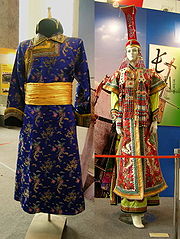.gif)
Deel (clothing)
Encyclopedia

Mongols
Mongols ) are a Central-East Asian ethnic group that lives mainly in the countries of Mongolia, China, and Russia. In China, ethnic Mongols can be found mainly in the central north region of China such as Inner Mongolia...
and other nomadic tribes of Central Asia
Central Asia
Central Asia is a core region of the Asian continent from the Caspian Sea in the west, China in the east, Afghanistan in the south, and Russia in the north...
, including various Turkic peoples
Turkic peoples
The Turkic peoples are peoples residing in northern, central and western Asia, southern Siberia and northwestern China and parts of eastern Europe. They speak languages belonging to the Turkic language family. They share, to varying degrees, certain cultural traits and historical backgrounds...
, and can be made from cotton
Cotton
Cotton is a soft, fluffy staple fiber that grows in a boll, or protective capsule, around the seeds of cotton plants of the genus Gossypium. The fiber is almost pure cellulose. The botanical purpose of cotton fiber is to aid in seed dispersal....
, silk
Silk
Silk is a natural protein fiber, some forms of which can be woven into textiles. The best-known type of silk is obtained from the cocoons of the larvae of the mulberry silkworm Bombyx mori reared in captivity...
, or brocade
Brocade
Brocade is a class of richly decorative shuttle-woven fabrics, often made in colored silks and with or without gold and silver threads. The name, related to the same root as the word "broccoli," comes from Italian broccato meaning "embossed cloth," originally past participle of the verb broccare...
.
It is still commonly worn outside major towns, and especially by herders. In urban areas, deels are mostly only worn by elderly people, or on festive occasions. The deel appears similar to a caftan or an old European folded tunic
Tunic
A tunic is any of several types of clothing for the body, of various lengths reaching from the shoulders to somewhere between the hips and the ankles...
. Deels typically reach to the wearers knees and fan out at the bottom and are commonly blue, olive, or burgundy, though there are deels of most colors.
The deel looks like a big overcoat when not worn. Instead of buttoning together in the middle, the sides are pulled against the wearers body, right flap close to the body with the left covering. On the right side of the wearer are typically 5 or 6 clasps to hold the top flap in place. There is one clasp below the armpit, three at the shoulder, and either one or two at the neckline.
A deel is usually worn with a large belt, usually made of silk
Silk
Silk is a natural protein fiber, some forms of which can be woven into textiles. The best-known type of silk is obtained from the cocoons of the larvae of the mulberry silkworm Bombyx mori reared in captivity...
. The area between the flaps and above the belt creates a large pocket in which Mongolians keep many things, Mongolian men will occasionally even carry entire handles of vodka in their deel. Though there is no major difference in material or outline between male and female deels, females tend to wear the 'pocket' closer, while males may have both larger pockets, looser fit, and wider sleeves.
In Mongolia, the usage of the word has been extended to cover other long winter coats as well. For example fur and leather overcoats of western design are referred to as "nekhii deel" and "sawkhin deel" respectively, meaning "fur deel" and "leather deel". Nevertheless, other Mongol regions, such as Bortala
Börtala
Bortala may refer to:#Bortala Mongol Autonomous Prefecture, a prefecture in Xinjiang, China#Bole, Xinjiang, a city in Bortala Mongol Autonomous Prefecture...
in Xinjiang
Xinjiang
Xinjiang is an autonomous region of the People's Republic of China. It is the largest Chinese administrative division and spans over 1.6 million km2...
retain the specific meaning of the word "deel" as the traditional garment, and refer to other overcoats as "olondoi".
Types

Khalkha
Khalkha is the largest subgroup of Mongol people in Mongolia since 15th century. The Khalkha together with Tsahar, Ordos and Tumed, were directly ruled by the Altan Urag Khans until the 20th century; unlike the Oirat people who were ruled by the Dzungar nobles or the Khorchins who were ruled by...
Mongol deel opening edges are round while a Buryat deel's is square. It can also vary among other tribes such as Chakhar, Torguud, and Ujumchin. Deels are designed for different occasions and environments. The design also varies due to function. There are deels for ceremonies like weddings and holidays and deels for daily wear. Deels for special occasions have their outer layer made of silk
Silk
Silk is a natural protein fiber, some forms of which can be woven into textiles. The best-known type of silk is obtained from the cocoons of the larvae of the mulberry silkworm Bombyx mori reared in captivity...
while the common deels are usually made up of cotton
Cotton
Cotton is a soft, fluffy staple fiber that grows in a boll, or protective capsule, around the seeds of cotton plants of the genus Gossypium. The fiber is almost pure cellulose. The botanical purpose of cotton fiber is to aid in seed dispersal....
and other relatively inexpensive materials.

